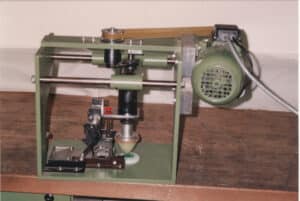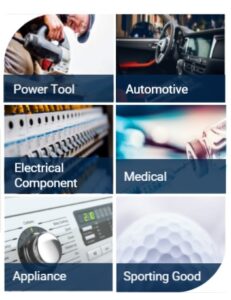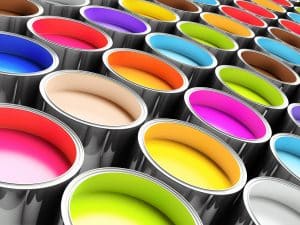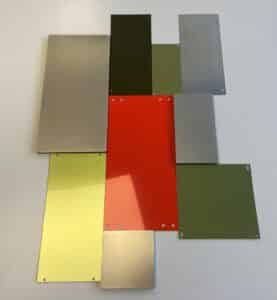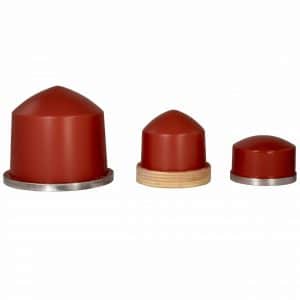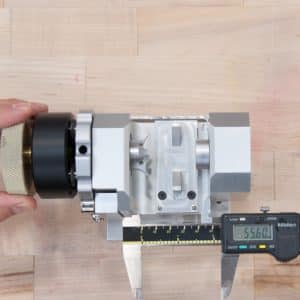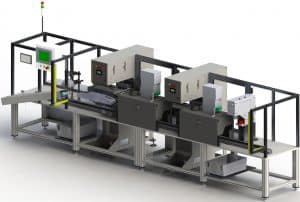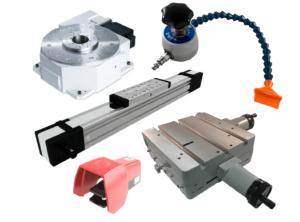Pad Printing 101
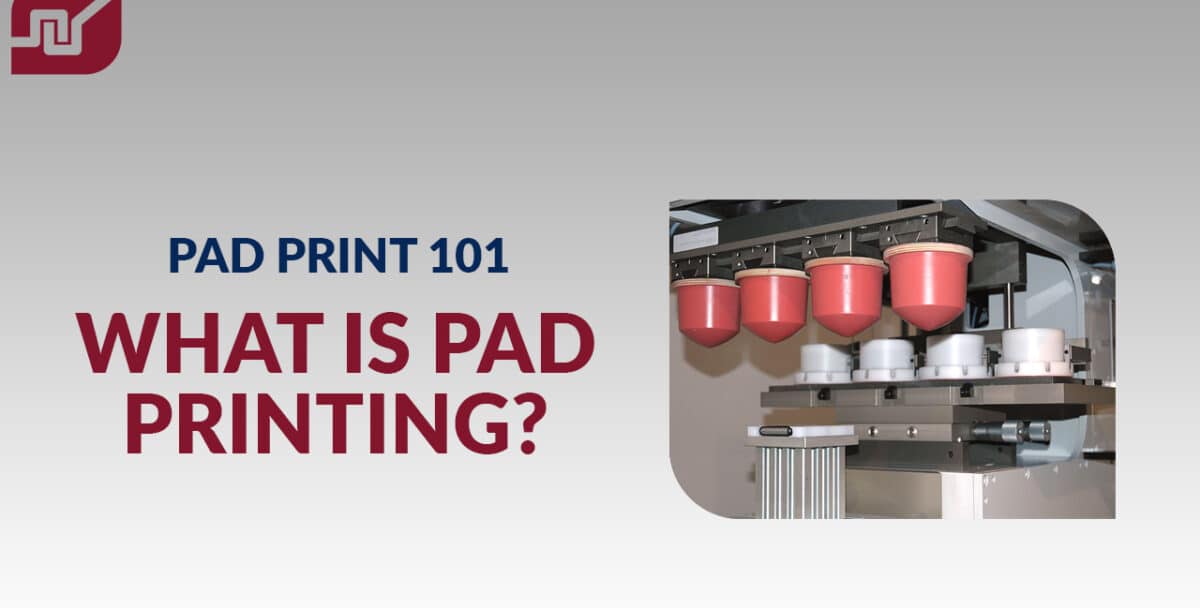
What Is Pad Printing?
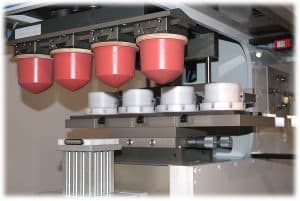
Several different techniques are available for companies looking to apply branding, indication, safety, or instruction information to their products. Pad printing is an attractive option for product decoration due to its repeatable, durable, and precise results.
Also known as tampon printing, tampo printing, or tamponography, pad printing is a product decorating process that transfers 2-dimensional images onto nearly any 3-dimensional object.
Pad Printing ensures decoration that is durable and highly repeatable for mass production. It is an ideal process for products across numerous industries.
History of Pad Printing
Pad printing was invented in the mid-20th century. Here is a brief overview of the history of pad printing:
- Early Developments:
- Pad printing originated in the 1950s and 1960s in Switzerland, where engineers and inventors sought a new printing method that could precisely transfer ink onto irregularly shaped objects.
- The technique was initially developed for the watchmaking industry, which required a method to print on small, curved, and intricate watch dials and cases.
- First Pad Print Machine:
- The credit for the invention of pad printing is often attributed to Engelbert Pechlaner and/or Wilfried Philipp. Historical accounts vary, but it is widely agreed that the first application was watch decoration.
- The first pad print system consisted of a silicone rubber pad (also called a tampon) that could pick up ink from an etched plate and then transfer it onto various surfaces. This pad was instrumental in making pad printing a practical and efficient method for industrial applications.
- Industrial Adoption:
- Pad printing quickly gained popularity in the automotive, electronics, and toy industries due to its ability to print on uneven and curved surfaces.
- The technique was particularly valuable for applying logos, serial numbers, and other markings on products with complex shapes, such as automotive parts, electronic devices, and plastic toys.
- Advancements and Automation:
- Over the years, pad printing technology has seen various advancements, including the development of more sophisticated printing machines and the refinement of inks and printing plates.
- Automation and computerization have also significantly improved the precision and speed.
- Shift from “Open-Well” to “Sealed Ink Cup” Pad Print Machines:
- One major advancement in pad print technology was a general shift from “Open-Well” or “Closed Ink Cup” to “Sealed Inkcup” pad print machines.
- While some applications continue to use “Open-Well” systems, the bulk of the market shifted to “Sealed Ink Cup” machines due to the numerous advantages these systems provide.
- Advantages of “Sealed Ink Cup” or “Closed Ink Cup” pad print machines include better print quality, superior ink management, and reduced solvent emissions.
- Expansion into Various Industries:
- Pad printing expanded beyond its initial applications and became a versatile printing method used in various industries, including medical devices, aerospace, promotional products, and more.
- Its ability to print on various materials, including plastics, metals, glass, and ceramics, has contributed to its widespread use.
What Pad Printing Can Do: Advantages & Common Uses
Pad printing is a versatile process with several advantages.
- Large Range of Substrates:
- Pad printing can be used on various substrates, including plastics, metals, glass, ceramics, wood, etc. It is suitable for both flat and irregularly shaped surfaces, making it highly versatile for decorating products.
- Precision Decoration:
- This printing method allows for the precise placement of ink on the target surface. It can achieve fine details and high-resolution graphics, making it suitable for applications where image clarity and accuracy are essential. Pad printed products can feature photograph-quality graphics and very high tolerance marking precision.
-
Durability:
- Pad printing inks are often durable and resistant to wear, fading, and environmental factors. This makes pad printing ideal for producing long-lasting markings, labels, and graphics on products.
- Range of Decoration Options (graphics, text, barcodes, and more):
- Pad printing excels at printing fine text, barcodes, and serial numbers, making it suitable for applications where product identification and traceability are critical.
- Pad printing machines are capable of handling multiple colors in a single pass. This enables the creation of intricate and colorful designs on products, making pad print well-suited for branding decoration.
- Adaptability to 3D Shapes:
- The flexible silicone rubber pad used in pad printing can conform to the contours of three-dimensional objects. This feature allows for printing on curved, uneven, or irregular surfaces that are challenging for other printing methods.
- Cost-Effectiveness:
- Pad printing is often a cost-effective solution for small to medium print runs, as it requires minimal setup time and can be used with relatively low-cost equipment. It is also efficient for producing complex graphics without expensive tooling.
- Quick Setup and Changeovers:
- Pad printing machines can be set up relatively quickly, and color changeovers are efficient, especially in sealed ink cup systems. This reduces downtime and increases productivity, making it suitable for small-scale and customized production.
- Wide Range of Inks:
- Pad printing supports various ink types, including solvent-based, water-based, UV-curable, and specialty inks. This flexibility allows for customization to match specific substrate requirements and industry standards.
- Environmental Friendliness & Compliance with Industry Standards:
- Advances in pad printing technology have led to developing environmentally friendly ink formulations, reducing solvent emissions and promoting sustainability.
- Pad printing is often chosen in industries like automotive, medical devices, and electronics because it can meet strict quality and labeling requirements.
|
Additional Resources |
Videos & Blogs:
|
Where Pad Print Decoration Is Used:
Common Applications
Pad printing’s versatility, precision, and cost-effectiveness have made it a popular choice for a wide range of applications. Pad print adds branding, measurement, indicator, safety instruction, and certification information to products from many industries. Common applications for pad print decoration include:
- Power Tools:
- Power Tools, Outdoor Power Equipment, Hand Tools, Tool Accessories & Components
- Automotive:
- Interior, Exterior, Underhood
-
- Circuit breaker switches & housing, plugs & switches, electrical coils & thermostats
- Medical Devices:
- Medical Devices & Components, Syringes (Traditional, Safety and Auto-Injectors), Measurement Disks & Wheels, Catheters & Medical Tubing
- Appliances:
- Refrigerators / Freezers, Dishwashers, Coffee Makers, Vacuums, Small Appliances, Garage Door Openers, Faucet Knobs / Shower Taps
- Sporting Goods:
- Golf Clubs & Balls, Baseballs & Bats, Ski Bindings, Helmets, Bicycle Shafts, Recreational Sporting Equipment
| Additional Resources | Videos & Blogs: |
How Does Pad Printing Work?
Components & Process
Pad printing is an offset printing process that uses an etched plate and pad to transfer an image onto a product or component. Understanding how pad printing works requires understanding the main pad printing supplies and processes.
–Pad Printing Components
Pad Print Ink
| What is pad print ink? | Pad print ink is specially formulated for use in pad print decoration and has several characteristics that make it suitable for the task:
|
| How to select a pad print ink? | The experts in the Trans Tech Ink Lab are deeply familiar with ink performance and the entire pad printing process. This allows us to stand out in our ability to provide custom inks painstakingly designed to meet your specific application requirements. We understand how product geometry, production environment, and substrate characteristics combine to determine which pad printing ink will provide optimal results for your project.
Experts in the Trans Tech Ink Lab can identify the best formulation for your decorating needs after considering a wide number of factors, including:
|
| Types of pad print ink? | Solvent-Based Inks
High-Speed Inks
High-Performance Inks
Solvent-Based Inks
|
| Trans Tech Ink Expertise |
Trans Tech is proud to be the market leader in three key areas related to pad print ink.
First – Our inks are widely considered the most durable available in the market today. Our deep expertise in the entire pad printing process- including machines, supplies, and services- allows us to engineer ink with standout durability. Second- Trans Tech has the largest ink warehouse in North America. Our wide selection of pad printing inks allows Trans Tech to stand out as a leader. Finally- The experts in Trans Tech´s Ink Lab combine industry-leading expertise with cutting-edge technology to provide superior ink-related support services. |
| Trans Tech Ink Range | Trans Tech offers a market-leading range of standard pad print inks. We offer 30 different standard ink lines, 7 of which are widely used in North America.
Beyond that- Trans Tech offers a wide range of standard colors. In addition to 28 standard colors, we offer 12 C-Mix colors for simplified color matching in many ink lines. We offer both metallic and process colors. |
| Ink-Related Services | Quality pad print suppliers can move beyond standard pad print ink lines to offer custom inks to match your performance or aesthetic requirements precisely. Please see the pad print ink additives section below to learn how inks can be modified to meet specific performance requirements.
Aesthetic Ink Services: For over 25 years, Trans Tech has invested in the latest cutting-edge spectrophotometer technology. We currently use two spectrophotometers to ensure our customers receive a precise color performance batch after batch with the highest accuracy. All color batches are kept within a delta E color variance of 2 or less!! To ensure absolute consistency from batch to batch- custom color formulas are kept on file, ready for next time. |
| Additional Resources | Videos & Blogs:
|
Pad Print Ink Additives
| What are pad print ink additives? | Pad printing ink additives are substances or compounds added to pad printing ink formulations to modify their properties and improve performance in various ways. These additives can enhance the ink’s adhesion, drying time, durability, or other characteristics to meet specific printing requirements. |
| Do I need a pad print ink additive? | The choice of additives and their specific formulations will depend on the type of pad printing ink, the substrate being printed on, and the desired print quality and durability. Quality pad print partners can tailor ink formulations by adjusting the types and quantities of additives to meet the unique requirements of each printing application. |
| Types of pad print ink additives? | Here are some common pad printing ink additives and their purposes:
|
| Additional Resources | Videos & Blogs:
|
Pad Print Plates (Clichés)
| What is pad print plate? | A pad printing plate, or cliché, is a flat metal or plastic plate used in the pad print decoration process.
Pad print decoration involves transferring an image from an etched plate to a product using a silicone pad. The pad printing plate is etched with the desired image or text, and ink is applied to this etched surface. When the silicone ink pad presses down on the flat printing plate, the ink is transferred to the pad, which stamps the image onto the product or component being decorated. The pad printing plate is an important element in the pad printing process, as it determines the quality and accuracy of the printed image. The quality of the plate depends on many factors, including the image resolution, etching depth, and the type of material used for the plate. |
| How to select a pad print plate? | Our designated plate-making team has over 100 years of combined experience in pad printing. We know how to carefully study all relevant factors to recommend the printing plate that best fits your specific needs.
Specifically- we look at:
|
| Types of pad print plates? | What printing plate materials are widely used in pad print decoration? Pad printing plates are made out of either plastic polymers or steel. The two different types of plates differ in etching techniques, life span, and precision.
Generally speaking, plastic pad print plates are more cost-effective than steel cliches. Depending on the type of plastic polymer used, these plates’ lifespan typically ranges between 15,000 and 100,000 impressions. Both thin and thick steel pad printing plates are highly durable, providing unmatched performance. A thin steel plate will have a 1mm profile and can provide up to 150,000 impressions. Thick steel plates have a 10mm profile and can provide up to 1 million impressions. Both thin and thick steel plates provide crisp, clean lines and critical image alignment for high-tolerance applications. Thick steel plates provide the highest level of precision and repeatability available. |
| Trans Tech Plate Expertise |
Trans Tech is proud to be the global leader in the manufacture of pad print plates. We stand out not only for our wide range of both plates and plate-related services but also for our market-leading plate etch accuracy. |
| Trans Tech Range | Trans Tech provides both blank and fully etched pad printing plates.
Frequently, plastic plates are sold blank to be etched by our customers in-house, whereas steel plates are etched at Trans Tech before shipping. Plastic pad print plates are typically etched with an alcohol or water wash. Some plastic plates are compatible with CO2 laser engraving. Both thick and thin steel plates are precision acid etched. Our printing plates are available in both standard and custom sizes. Our standard plate sizes are We also offer custom-sized plates ranging from smaller 60 x 60 mm plates up to plates as large as 1000mm in length (for these larger plates, the maximum exposure area is 900 mm by 610 mm. Pad printing plates can be sent unpunched or with punched holes/slots for use on Trans Tech or competitor pad print equipment. |
| Plate-Related Services |
Artwork Expertise Experts in our Art Studio have an average of over 20 years of experience in turning your vision into quality pad-printed reality. We know how to get it right the first time – ensuring fewer problems on the production floor. Finding a partner with experience in areas such as finely detailed artwork and registration is key. Expertise in artwork requirements for specialty-depth, critical-line, and multi-depth etching is also key.Precision Etching Etching accuracy is key to ensuring highly repeatable, quality pad print decoration. Access to precision-etched plates reduces both scrap and troubleshooting downtime. Trans Tech provides etching on thick and thin steel pad print plates with market-leading accuracy. For stand-out precision, Trans Tech ensures meticulous control over the entire print plate etching process. With superior artwork expertise and careful plate material selection, we ensure each etched plate is cued for success from the beginning. Next, we use cutting-edge technology to ensure unmatched artwork placement and plate etch depth precision. Taken together, these last two steps allow us to provide stand-out repeatability. We issue a multi-point quality report with every etched plate we ship to provide our customers with complete peace of mind. |
| Additional Resources | Videos & Blogs: |
Pad Printing Pad
| What is a pad print pad? | A pad print pad, or a printing pad or transfer pad, is a crucial component in pad printing as it transfers ink from the cliché to the object being printed.
Pad printing pads are crucial for achieving high-quality and precise prints. The choice of pad material and size depends on the specific requirements of the printing job, such as the shape of the object and the desired print quality. |
| How to select a pad print pad? | To select the optimal printing pad for your unique application, it is essential to consider the following elements:
Pad Shape Pad Size Pad Durometer (hardness) Substrate Features/Finish Printing Equipment Features Image characteristics |
| Types of pad print pads? | A wide range of standard and custom formats are available, including:
|
| Trans Tech Pad Expertise |
UNIQUE IN THE INDUSTRY- Express Pads Unprecedented Time Savings for Pad and Ink Changes
FIRST IN THE INDUSTRY – DIGITAL SILICONE MIXER
FIRST IN THE INDUSTRY – Laser Base Cutter
|
| Trans Tech Pad Range | Trans Tech offers over 1,000 different pad shapes and sizes to fit virtually every application and state-of-the-art custom pad-making capabilities.
Our Pads:
|
| Pad-Related Services |
|
| Additional Resources | Videos & Blogs:
|
Ink Cups
| What is pad print ink cup? | A pad print ink cup contains and transfers ink to the silicone or rubber pad (transfer pad), which then transfers the ink to the printed object.
The key characteristics of a pad print ink cup include its ability to contain the ink, maintain a consistent and sealed environment, and facilitate the controlled transfer of ink to the transfer pad. |
| Types of pad print ink cups? | Inkcups come in various sizes and configurations to accommodate different machines and printing requirements. Inkcups are commonly available:
|
| Trans Tech Expertise | Our innovative adaption of this industry-standard design has produced a revolutionary method for containing ink for closed cup pad printing machines.
Trans Tech’s SpaceFrame TM consists of a red anodized aluminum ring, used with the patented ExpressLiner disposable reservoir, and easily replaceable carbide metal rings. Simplicity & Convenience
Unparalleled Savings
|
| Trans Tech Range |
Both are available with mechanical or magnetic hold-down in 60mm, 90mm, or 130mm sizes. |
Holding Fixtures

| What is pad print holding fixture? | Highly repeatable product decoration starts at the holding fixtures. If your part is not held securely at precisely the right angle, achieving quality repeatable decoration is impossible. A successful holding fixture will securely hold your piece in place while also providing operator ease of use. |
| How to select a holding fixture? | Highly skilled fixture teams can custom-build a fixture to meet the precise needs of your application after considering the following elements:
|
| Trans Tech Range of Holding Fixtures | We design fixtures for:
Fixture Types: Substrates: |
| Trans Tech Holding Fixture Expertise | Our engineers have solved the age-old challenge of customers choosing between cumbersome fixtures that provide secure product hold but are time-consuming and difficult to use and user-friendly holding fixtures that fail to provide firm product stabilization.
We carefully design our fixtures so that they work only in one way – ensuring precise product positioning time and time again. Our customers are so happy with the results – they came up with the descriptor “error-proof” for our fixtures! Our fixtures feature an easy 2-step “Load & Lock” process where rollers, push pins, or simple clamps ensure operator-friendly performance, combining precision alignment, firm hold, and quick loading and unloading. |
Pad Print Supplies: Enhanced Efficiency & Superior Results
The quality of the pad print consumable supplies you choose will go a long way in determining the quality of pad print decoration you achieve. Finding a partner with expertise in pad print machines and supplies ensures you have an expert who knows how to ensure all components are designed to work together for optimal results. High-quality pad print consumables enable superior decoration quality and generate significant time and cost savings.
| Additional Resources | Demonstration- Efficient Pad Print Consumables Set Up (Ink, Ink Cups, Liners & Printing Plates) (Video) (Blog) Save on Pad Printing Supplies (Video) (Blog) |
–Pad Printing Process
The pad print cycle is highly adaptable to each unique application. In some instances, pre- and post-treatments enhance results. More information on these treatments appears below. Here is a general overview of the main steps in pad print decoration:
- Artwork Preparation: The first step in the pad printing process is to create the artwork or design that will be printed. This design is typically converted into a digital format and used to create the printing plate. The printing plate (or cliché) contains the image or design to be printed.
- Ink Preparation: The appropriate pad printing ink is selected and prepared for use.
- Ink Cup and Cliché Setup: The cliché is positioned below the ink cup, and the cliché’s surface is coated with the selected ink.
- Ink Pickup: As the ink cup is pressed against the cliché (covering the engraved design), it picks up ink from the recessed areas of the design due to the ink’s adhesion properties.
- Transfer to the Pad: After picking up the ink, the ink cup is lifted away from the cliché, and a silicone pad (printing pad) approaches the ink cup. The silicone pad deforms and conforms to the shape of the ink cup, picking up the ink from its surface. As the printing pad lifts away, the tacky ink film inside the engraved artwork area is picked up onto the pad.
- Printing: The ink-loaded transfer silicone pad is then moved to the object or substrate to be printed. The pad is pressed against the substrate, conforming to its shape and transferring the ink from the pad to the substrate’s surface. The pad’s flexibility allows it to adhere to curved or irregular surfaces, ensuring a precise and consistent print. This completes one print cycle.
- Drying and Curing: Depending on the ink used, the printed image may require drying and curing to ensure adhesion and durability. This step can involve air drying, UV curing, or heat curing.
- Quality Control: After printing, the printed products may undergo quality control checks to ensure that the printed images meet the desired standards for clarity, color accuracy, and adhesion.
- Cleaning and Maintenance: The ink cup and transfer pad are typically cleaned and maintained to prevent ink contamination and ensure consistent printing quality for subsequent runs.
Types of Pad Print Machines
There are various types of pad printing machines available, each designed to meet specific printing needs and production requirements. These machines differ in size, complexity, and automation levels. Pad print equipment is classified in many different ways. It is common to see pad printing equipment classified by their level of automation, the number of colors the system is designed to deliver, or the type of driver the system has.
–Manual, Semi-Automated & Fully-Automated Pad Print Machines
Manual Pad Print Machines
| What are manual pad print machines? | Manually operated machines are suitable for high-performance, low-volume printing jobs. They are cost-effective and often used for short runs, small components, or prototypes. Operators manually load and unload parts and control the printing process. |
| Additional Information | Aero Pad Printing Machine: Features Overview (Video) (Blog) |
Semi-Automated & Fully Automated Pad Print Machines
| What are semi-automated and fully automated print machines? | Pad printers can be used on their own, independent from other systems. However, pad printing equipment can also be incorporated into semi- or fully automated systems.
Semi-automatic machines are an intermediate option between manual and fully automatic machines. They are suitable for moderate production volumes. While they still require manual loading and unloading of parts, they offer features like programmable ink cup movement and the ability to print multiple colors in a single pass. Fully automatic pad printers are highly automated and designed for high-volume production. These machines can load, print, and unload parts without manual intervention. |
| Benefits of Automated Lines | There are multitudes of potential benefits to be gained from automating the process. Automation can generally increase output/productivity, line speeds, safety, and repeatability while decreasing reject/scrap rates, manpower requirements, and factory lead times. |
| Common Components of Semi- and Fully Automated Pad Print Lines |
Part Feeder: Fully Automated Systems: Automated, typically into a bowl-feeder. Part presence sensors are incorporated for automated verification of presence and orientation. Semi-Automated Systems: Manual operator loading onto a nested fixture. Part presence sensors may be incorporated for automated verification.Safety: Full hard guarding around the system, safety light curtains, and safety laser scanners are typically used.Part Nesting Fixtures: The part to be decorated fits into the precision-designed nesting fixtures. Depending on the requirements, rotating fixtures or vacuums may be incorporated.Transport: Depending on the system configuration, multi-position dial tables or linear slides may be utilized.Printers: 1 or more standard pad printers may be incorporated based on the decoration requirements.Treatment: Pre-treatment and/or post-treatment systems may be incorporated based on the application requirements.Vision Inspection: A custom-developed vision inspection system and automated accept/reject stations may be incorporated. |
| Additional Information | Semi-Automated Pad Print System (Video) (Blog) |
–Single & Multicolor Pad Print Machines
Pad printers can be categorized based on the number of colors they can print in a single pass. Single-color machines are suitable for simpler designs, while multicolor machines can print more complex and colorful images in a single operation. Many machines can operate as single or multicolor depending on customer needs.
| Additional Information | 4 Color Pad Printing: Efficient Multicolor Decoration in a Single Sequence (Video) (Blog) Aero (Multicolor) Pad Printing Machine: Features Overview (Video) (Blog) Flexible Single or Multicolored Pneumatic Pad Printer – Orion (Video) (Blog) |
–Pneumatic & Electro-Mechanical Pad Print Machines
| What are pneumatic and electromechanical pad print machines? | Electromechanical and pneumatic pad printing machines are two types of pad printers that use different mechanisms for their operation. They have distinct advantages and disadvantages, and the choice between them depends on specific application requirements. Here’s a comparison of electromechanical and pneumatic pad printing machines. |
| Electromechanical Pad Print Machine Benefits |
|
| Pneumatic Pad Print Machine Benefits |
|
| Which type is right for me? | The choice between electromechanical and pneumatic pad printing machines depends on factors such as the required precision, production volume, budget, and maintenance considerations. Electromechanical machines excel in precision and flexibility but may be more expensive and require more maintenance. Pneumatic machines offer simplicity, cost-effectiveness, and reliability, making them suitable for a wide range of applications. |
| Additional Information | (Pneumatic) Flexible Single or Multicolored Pad Printer – Orion (Video) (Blog) (Pneumatic) Aero Pad Printing Machine: Features Overview (Video) (Blog) (Electromechanical) SealCup Express: Features Overview (Video) (Blog) |
–Special Format Pad Print Machines
Some applications require special format pad print machines. Two popular examples are Rotary Pad Print Machines and Cup Slide Pad Print Machines.
| Rotary Pad Print Machines | Rotary pad printers are specialized machines used for cylindrical or curved surfaces, such as pens, bottles, and tubes. They can print 360-degree designs around the circumference of a part. Rotary machines often have multiple pads and can print multiple colors simultaneously.
Unique in the industry, the Trans Tech Single-Head Rotary Gravure Pad Printer can provide superior 360° decoration on cylindrical, round, oval, or conical-shaped parts at speeds up to 9x faster than standard high-speed pad printers. |
| Flexible Pad Print Machines – Image Size | Some pad printer machines, like the Orion, can print images of varied sizes (the system can run 60-, 90-, and 130-mm cups simultaneously).
A Cup Slide can be added to print truly long or large images. The Orion 130, with an optional cup slide, can print images 3.5x longer than those rendered by traditional pad print machines. Images as long as 460mm can be applied to products or components (compared to 130 mm with a traditional pad print machine). Printing long images is ideal for a wide range of applications, including medical tubing and catheters. |
| Flexible Pad Print Machines- Decorated Image | Some pad print machines are designed to give users great flexibility in terms of the type of image printed. For example, the Orion from Trans Tech allows users to:
|
| Additional Resources | High-Speed Rotary Pad Print Decoration (Video) (Blog) Flexible Single or Multicolored Pad Printer – Orion (Video) (Blog) Pad Print Decoration of Large or Long Images- Orion (Video) (Blog) |
Auxillary Pad Print Equipment

| What is Auxillary Pad Print Equipment? | Auxiliary pad printing equipment refers to additional tools, devices, and accessories used in conjunction with pad printing machines to enhance the pad printing process’s efficiency, quality, and versatility. These auxiliary tools and equipment are often essential for specific applications or tasks within the pad printing workflow. |
| Pre-Treatments | Pre-treatments are applied to the surface of the substrate to be decorated before pad printing to ensure superior ink adhesion. Flame, corona, and plasma treatment machines help make the substrate responsive to the ink and achieve a more durable print.
Flame Treatment Corona Treatment Plasma Treatment Each of these pre-treatment methods has its strengths and is chosen based on the substrate material, the desired ink adhesion, and the specific printing requirements. Proper surface preparation is critical for achieving good print quality and adhesion in pad printing, as it ensures that the ink adheres well to the substrate and produces durable and high-quality prints. |
| Post-Treatments | Post-treatments are designed to speed the ink drying process – ensuring durable print ready for packaging.
Drying Tunnels UV Curing |
| Safety Packages | OSHA requires systems to prevent operators from reaching the point of operation when the machine is running. There are three main types of safety packages for pad print equipment.
Full Guard Package Small Guard Package Two-hand Anti-Tie Down Package |
| Pad Blowers | Pad blowers perform two essential functions:
Trans Tech offers both anti-static and magnetic pad blowers. Anti-static pad blowers are primarily used to minimize the effects of static electricity on the pad’s surface, which can attract dust and debris. They help maintain a clean pad surface for better print quality. On the other hand, magnetic pad blowers securely hold the pad on the printing machine, ensuring stability during the printing process and facilitating easy pad changes. Both types of blowers play essential roles in the pad printing process, contributing to efficient and high-quality printing results. |
| Cliché (Printing Plate) Preparation Equipment: |
|
Pad Print Alternatives
Pad printing´s ability to apply multicolor, durable decoration to a wide range of substrates, including plastics, metals, glass, and ceramics has made it a popular decoration solution. Its ability to adapt to irregular and contoured surfaces makes it suitable for a variety of products and materials.
Hot Stamp Decoration
The hot stamp decoration process will be an attractive option for those looking to achieve the highly sophisticated look provided by metal stamping. Hot stamping can provide an elegant, shimmering finish that conveys opulence and exclusivity, making it a popular choice for luxury packaging, branding, and high-end products.
Our sister company, United Silicone, is a leading provider of hot stamp equipment and supplies.
Digital Printing
Digital printing is a viable option for those seeking variable data printing, and quick setup for short runs. We have prepared a comprehensive comparison of digital and pad print decoration.
Screen Printing
Screen printing involves pushing ink through a mesh screen onto the substrate. It is known for its versatility, screen printing is capable of printing on textiles, paper, plastics, glass, and metal. Screen printing produces vibrant, opaque colors and is particularly effective for bold, large designs. However, setup costs for screen printingcan be high, making it more cost-effective for larger print runs. Screen printing excels in durability, with prints capable of withstanding multiple washes and environmental exposure.
What To Look for in Pad Print Machine Manufacturer
In addition to finding a pad print supplier with a full range of pad print equipment and supplies, it is helpful also to ensure any potential pad print supplier offers the following:
- High-tech Art Lab: using specialized graphic arts equipment and a team experienced in solving unique pad print challenges
- Dedicated Test Lab: for research on ink-to-substrate compatibility, pad suitability, image distortion, and customer training
- Complete Platemaking Facilities: for processing and etching steel and plastic clichés
- Machine Shop: for building, testing, and machine service
- Tooling Department: For holding fixture design, build, and testing.
- Ink Lab: For ink mixing and precision color matching
- Automation Team: With deep expertise in high-volume industrial applications, including part indexing, orientation, load and unloading, and pre-and post-treatments.
How To Get Started With Pad Printing
When exploring your pad printing options, make sure to find a partner who listens to your unique decorating challenge and has the expertise to create a customized solution optimized for your specific needs.
Our team comprises seasoned professionals who understand production needs from the ground up. The average experience of our lab technicians is over 30 years. We have seen it all and understand how to create the best solution for your unique application. Speak with a Trans Tech Pad Printing Expert today to learn more.

Sigi Knappik is the Consumables & Quality Manager at ITW Trans Tech. During his 29 years working in the pad print industry, he has held a number of roles including purchasing, quality and operations management.

